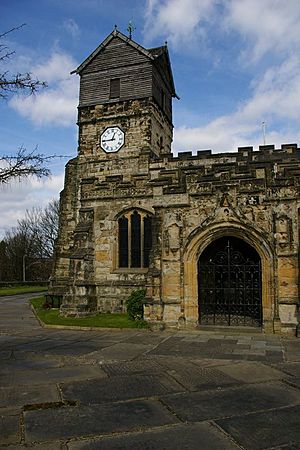Richard Assheton of Middleton facts for kids
Richard Assheton (born 1483, died 1549) was an English soldier from Middleton. He fought in the famous battle of Flodden. He is also known for rebuilding St. Leonard's Church in Middleton. He paid for special stained-glass windows there to remember that battle. These windows are one of the oldest war memorials in England.
Contents
The Battle of Flodden and Its Windows
Richard Assheton gathered a group of archers from Middleton, near Manchester. They went to fight in the Battle of Flodden in 1513. An official record from 1533 noted Richard's bravery. It said he captured two important Scottish figures: John Forman and Alexander Burnett. John Forman helped identify the body of King James IV of Scotland after the battle.
Richard continued to rebuild St. Leonard's Church in Middleton. He asked for the "Flodden Windows" to be made. These windows show him and his wife. They also show seventeen captains of the archers. The priest Henry Taylor, who blessed them before the battle, is also pictured. Each person is named in the stained glass.
The windows are one of England's oldest war memorials. Only All Souls College, Oxford is older. That college was founded in 1438. Its members were asked to pray for those killed in the French wars.
What the Windows Say
The main writing on the glass was described in 1845. It said: "Pray for the wellbeing of Richard Assheton and those whose names and images they caused to be made in the window shown above, 1515."
Some people think the window might be older than 1515. This is because the date on the glass did not have an "X" for ten. They believe it might remember a religious group of archers from before the battle.
The names that can still be read include:
- Henricus Taylyer
- Richard Kylw (or Wyld)
- Hughe Chetham
- James Gerrarde
- John Pylkyngton
- Philipe Werburton
- William (Ste)le
- John Scolefede
- Wylliam (—)
- James Taylier
- Roger Blomeley
- Crystofer Smythe
- Henry Whitaker
- Robart Prestwyche
- Richard Bexwicke
A Poem About the Windows
A poem from the 1600s, called Iter Lancastrense, describes the window. It talks about going to Middleton church. It mentions the "painted window" showing the men leaving for war.
The poem says the Lord and Lady are shown in red. Then, a close attendant is in blue. The chaplain is also in blue, praying at an altar. After them are brave neighbors. They hold bows on their shoulders. Their belts are full of arrows. They wear blue coats. Their long, curly hair makes them look strong. Each person has their name. People say their children still live on the same lands.
Originally, there was more than one window. Richard and his wife were shown separately. Since 1847, the remaining glass has been put into one window. The window was fixed again in 2012.
Richard Assheton's Family
Richard Assheton married Anne Foulshurst. She was the daughter of Sir Robert Foulshurst. Their son was also named Richard Assheton. He married Anne Strickland first, and then Anne Lady Bellingham.
Richard's cousins were the Asshetons of Great Lever, Lancashire. Two of them became members of parliament. One was Richard Assheton of Whalley. The other was his half-brother Ralph Assheton of Great Lever. Ralph was a Member of Parliament for Liverpool in 1553.


